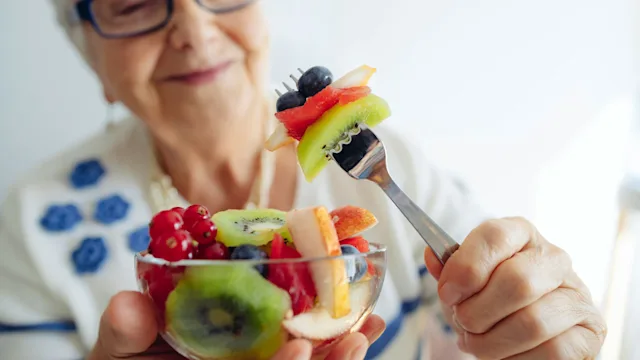Key takeaways:
Intuitive eating is a non-diet approach to eating that helps you listen and respond to your body’s natural hunger cues.
The 10 intuitive eating principles can help you create less stress and more enjoyment with food.
The benefits of intuitive eating may include better body image, higher self-esteem, and a healthier relationship with food.
Diets can be hard to follow, and the results often don’t last. And they can even be harmful to your health, as is the case with crash diets.
Intuitive eating is an alternative way to approach food that may be more realistic and sustainable in the long term. And it may leave you feeling good about yourself instead of frustrated by strict diet rules. This non-diet approach includes applying a set of 10 intuitive eating principles to promote a healthier relationship with food.
What is intuitive eating?
Intuitive eating is an alternative approach to food that involves both your mind and body. The concept was developed in 1995 by two dietitians, Evelyn Tribole and Elyse Resch. And it’s based on the idea that we are all born intuitive eaters who can regulate when and how much we eat without judgment. Yet, as we get older, many of us fall prey to rules and regulations around food, which causes us to stray from this natural skill.
With intuitive eating, you learn how to listen and respond to your body’s natural hunger cues, instead of being guided by dieting rules. This can help you to rebuild bodily trust, let go of judgment, and improve your relationship with food.
According to the theory behind intuitive eating, it’s not just about what you eat but also how you eat. Eating is meant to be enjoyable, nourishing, and satisfying. So, unlike a diet, intuitive eating doesn’t depend on willpower, and there are no restrictions involved.
10 principles of intuitive eating
The 10 intuitive eating principles make you the expert on your body, helping you follow your instincts about what and how to eat.
1. Reject the diet mentality
The first step to becoming an intuitive eater is letting go of the belief that the perfect diet is out there to solve your problems. Research shows that diets often do not work and can set you up for failure by making you more likely to gain weight in the long run. They can also lead to other health problems, such as developing an eating disorder or slowed metabolism.
2. Honor your hunger
Hunger is a necessary biological process that doesn’t need to be feared. Ignoring hunger cues deprives your body of important calories and nutrients and can lead to cravings and a desire to overeat. Visual tools like the hunger-fullness scale can help you get back in touch with honoring your hunger.
3. Make peace with food
This means giving yourself unconditional permission to eat what you want, when you want. Doing so allows you to let go of guilt and stop following rules to guide your eating. This leads to more enjoyment and less anxiety with food.
Read more like this
Explore these related articles, suggested for readers like you.
4. Challenge the food police
The food police is the internal voice in your head that says you are “good” or “bad” for eating certain foods or in a certain way. Since no single food can make you healthy or unhealthy on its own, it can be helpful to stop giving food so much power.
5. Discover the satisfaction factor
Eating is meant to be pleasurable and satisfying. Yet, when dieting, you may be tempted to fill up on foods you feel you are supposed to eat and avoid what you truly want. This often leads to eating more food to satisfy your hunger and can cause unintentional overeating. Eating what you really want helps you eat the amount you need.
6. Feel your fullness
This means slowing down while eating and paying attention to your body’s cues when they tell you that you’ve had enough. Give yourself permission to eat more or less, depending on how you feel. Using the hunger-fullness scale as a guide can also help with this principle.
7. Cope with your emotions with kindness
Food is often used as a coping mechanism to deal with difficult emotions. Although emotional eating isn’t always bad, finding healthy ways to comfort yourself and resolve your feelings without turning to food can be helpful.
It is common to feel out of control while eating when you are overly hungry or eat food you view as “bad.” While this may feel like emotional eating, it may just be your body recovering from restrictions, which will even out with time, proper care, and attention.
8. Respect your body
Dieting can create a negative body image, which may cause you to diet even more, creating a vicious cycle. Respecting and loving your body means listening to its cues, caring for it physically and mentally, and practicing kind self-talk. Doing so will allow you to feel better about yourself and celebrate your uniqueness.
9. Exercise and feel the difference
While exercise is beneficial for your health, it’s important to do it for the right reasons. Exercising as an intuitive eater means doing what you enjoy and what feels good, not just as a way to burn calories or earn the right to eat certain foods.
10. Honor your health with gentle nutrition
Choosing nourishing foods is essential, but you don’t have to eat perfectly to be healthy. As an intuitive eater, you will learn to choose healthy foods because you want to and not because you feel like you have to.
How do you use the hunger-fullness scale in intuitive eating?
The hunger-fullness scale is a visual guide to help you identify how your body feels before, after, and when you eat. It encourages you to quantify your level of hunger or fullness on a scale from 1 to 10 — with 1 being the maximum level of hunger and 10 being the maximum level of fullness.
You rate your hunger or fullness level based on your perception. To be the most accurate, ratings must be based on perception, not how you believe you “should” feel.
Here is what each number on the scale represents:
1 | Completely starving, often accompanied by no energy and weakness |
2 | Very hungry, possibly accompanied by symptoms of low blood sugar, such as feeling dizzy and weak |
3 | Uncomfortably hungry, in a way that may be distracting or make you irritable |
4 | Hungry, perhaps with your stomach growling |
5 | Starting to feel a little hungry |
6 | Satisfied, but not full yet |
7 | Full, but not uncomfortable |
8 | Overfull, feeling somewhat uncomfortable |
9 | Stuffed and feeling very uncomfortable |
10 | Extremely stuffed, perhaps feeling nauseous or like you don’t want to move |
Using the hunger-fullness scale can also help you identify the best times to start and stop eating, so that you properly tend to your body’s needs. It is best to avoid reaching the highest and lowest numbers. Instead, try to hover around the middle numbers, from 4 to 7. Doing so can help prevent you from undereating or overeating and get you more in tune with your body’s cues.
What are the benefits of intuitive eating?
Many studies have shown that intuitive eating has potential benefits, including:
Better body image and self-esteem
Reduced likelihood to emotionally eat
Less stress, guilt, and shame associated with eating
Reduced risk of disordered eating habits or eating disorders
Decreased risk of cardiovascular disease
Can intuitive eating help with weight loss?
People who practice intuitive eating may lose weight, but weight loss is not the goal. Your weight may or may not change while following the principles of intuitive eating. But the many benefits you can experience may be even more important.
How to get started with intuitive eating
The 10 principles provide the framework for intuitive eating, but they are not rules. You can’t win or lose at intuitive eating.
It’s helpful to start by considering your health goals and current relationship with food. Then, ask yourself what you can do each day to gradually begin your journey to becoming an intuitive eater.
Just keep in mind that becoming an intuitive eater is not a quick fix. If you have spent years following or reading about mainstream diets, it will take constant practice to stray away from these habits and beliefs. Intuitive eating encourages you to be patient and gentle with yourself along the way, trusting that the results are well worth it.
Working with a trained and trusted healthcare practitioner can help provide you with support for your journey. They can answer your questions, dispel common myths and misconceptions, and help you overcome barriers to intuitive eating.
The bottom line
Intuitive eating is a revolutionary approach to food that doesn’t involve dieting or strict rules. The 10 intuitive eating principles guide your approach to food and your body and may help you develop a healthier body image and boost your quality of life.
Anyone can try out intuitive eating. Because it is so different from mainstream dieting, it may take time to understand and implement. But working with a healthcare professional trained in intuitive eating is a great way to give you the support you may need.

Why trust our experts?



References
Alberts, H. J. E. M., et al. (2012). Dealing with problematic eating behaviour. The effects of a mindfulness-based intervention on eating behaviour, food cravings, dichotomous thinking and body image concern. Appetite.
Christoph, M. J., et al. (2018). Nutrition facts use in relation to eating behaviors and healthy and unhealthy weight control behaviors. Journal of Nutrition Education and Behavior.
Galloway, A. T., et al. (2010). Retrospective reports of child feeding practices, current eating behaviors, and BMI in college students. Obesity.
IntuitiveEating.org. (n.d.). 10 principles of intuitive eating.
Maclean, P. S., et al. (2011). Biology’s response to dieting: The impetus for weight regain. American Journal of Physiology - Regulatory, Integrative and Comparative Physiology.
National Eating Disorders Association. (n.d.). kNOw dieting: Risks and reasons to stop.
Ruzanska, U. A., et al. (2019). Intuitive eating mediates the relationship between self-regulation and BMI - Results from a cross-sectional study in a community sample. Eating Behaviors.
Schaefer, J. T., et al. (2014). A review of interventions that promote eating by internal cues. Journal of the Academy of Nutrition and Dietetics.
St-Onge, M. P., et al. (2017). Meal timing and frequency: Implications for cardiovascular disease prevention: A scientific statement from the American Heart Association. Circulation.
UC Berkeley University Health Services. (n.d.). The hunger-satiety scale.
Warren, J. M., et al. (2017). A structured literature review on the role of mindfulness, mindful eating and intuitive eating in changing eating behaviours: Effectiveness and associated potential mechanisms. Cambridge University Press.
















